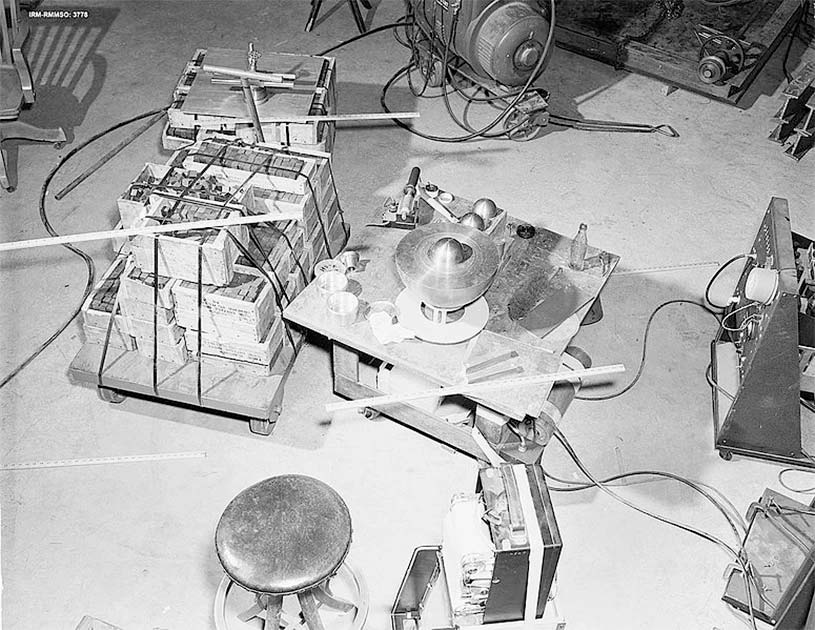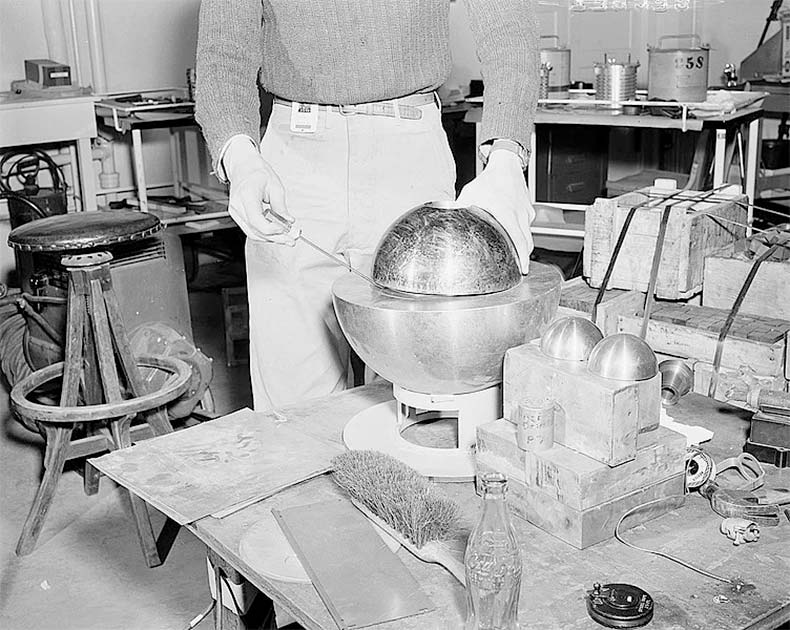During the Second World War, the United States launched a massive, secret, project to develop the world’s first atomic bomb. Dubbed the Manhattan Project, this clandestine research involved the collaboration of some of the brightest minds in science and engineering, who worked tirelessly to achieve this goal.
Among the many challenges they faced was the development of a deep understanding of the properties of plutonium, a rare and highly toxic element essential to the creation of the atomic bomb. Plutonium is highly unstable, and if too much is gathered on one place it will “go critical”, causing a deadly burst of heat and radiation.
In their quest for knowledge, the scientists created a subcritical mass of plutonium, which they named the “Demon Core”. This ominous object, with its unstable and unpredictable behavior, became a source of both fascination and fear for those who worked with it, and ultimately resulted in two tragic accidents that cost the lives of two scientists.
How was the power of such a deadly artifact harnessed by the scientists? And what happened to the people exposed to the Demon Core?
Why Was the Demon Core Created?
Building the world’s first atomic bomb was no easy task. During the Manhattan Project, the United States government gathered some of the world’s brightest minds in science and engineering to work on the development of an atomic bomb. The project required significant advancements in several areas.

One of these areas was the understanding of the properties of plutonium, a key ingredient in early atomic bombs. In an effort to develop a deeper understanding of the behavior of plutonium, the Demon Core was created.
The Demon Core project was led by the physicist and chemist Dr. Louis Slotin with the help of a team of scientists based at the Los Alamos Laboratory in New Mexico. The core was made by combining two half-spheres of plutonium-gallium, each with a mass of approximately 3.5 kilograms (7.7 lb), to create a larger sphere of subcritical plutonium with a mass of 6.2 kilograms (13.7 lb).
The core was created so that the scientists could carry out experiments designed to help them better understand plutonium’s properties, especially the criticality conditions required for a nuclear chain reaction (which leads to a big bang). The core’s unpredictable and unstable behavior made it an invaluable tool for studying the behavior of plutonium under a range of conditions.
It was also hoped that the experiments conducted with the core would also help scientists better learn how to handle and work with plutonium more safely. This research could then be used to develop criticality safety procedures to prevent nuclear accidents.
- Castle Bravo and the Shrimp: When Nuclear Testing Goes Very Wrong
- Anatoli Bugorski: Don’t Put Your Head Into A Particle Accelerator
Unfortunately, nothing with the Demon Core really went to plan. As we’re about to find out, it was called the Demon Core for a reason.
How it Got its Name
So why did the scientists working with this ball of plutonium call it the Demon Core? Because it was terrifying. The assembled core was designed to be at “-5 cents (a measure of radioactivity/ reactivity)”.
For those of us without physics degrees, this means the core was designed to be brought to the brink of a nuclear reaction without actually triggering one. The slightest change in conditions could cause the core to become very deadly, very quickly.
This made it incredibly unpredictable and dangerous to work with. The scientists had to be extremely careful when working with the core to avoid accidental criticality, which could result in radiation dumps and could quickly lead to a nuclear explosion.
According to historical accounts, the name “Demon” was chosen by physicist Raemer Schreiber, who was part of the team working on the core. Schreiber is said to have given the core its name because of its unpredictable and dangerous nature, and the name stuck among the scientists who worked with it.
Sadly, it lived up to its name.
The Accidents
It doesn’t matter how careful someone is, human error is always a factor, and the team at Los Alamos laboratory found this out the hard way. On August 21, 1945, physicist Harry Daghlian was working alone with the Demon Core.
He was carrying out a neutron reflector experiment by placing tungsten carbide bricks around the core, bringing it closer to criticality without actually triggering it. Each brick placed brought the core closer.
Tragically, as Daghlian was placing the final brick, he dropped it onto the core, causing the core to immediately go critical. Daghlian acted quickly and managed to remove the brick before the core blew but paid with his life. He had been hit by a deadly blast of neutron radiation.
Realizing what had happened, other scientists rushed into the room to aid Daghlian. He was taken to a nearby hospital where he was treated for acute radiation poisoning. Unfortunately, he died 25 days later. The Demon Core had claimed its first victim.
- Tsutomu Yamaguchi: The Unluckiest Man in the World
- Whoops! How did the US Misplace Six Nuclear Bombs?
The second accident happened less than a year later, on May 21, 1946. This time the victim was Louis Slotin. Much like in the case of the first experiment, Slotin was conducting an experiment with neutron reflectors when the accident occurred.

Slotin was regarded as being an expert on the core, having worked on it during the Manhattan Project from the early days. He was about to leave the project and was showing another scientist, Alan Graves, how to carry out the experiment. Unfortunately, Slotin was prone to bravado and showing off.
Slotin was performing a risky experiment known as “tickling the dragon’s tail” in which he used a screwdriver to slightly raise the upper beryllium hemisphere that surrounded the core, bringing it closer to criticality. Slotin knew that this experiment was extremely dangerous and required the utmost caution, but he decided to proceed anyway, without the proper equipment (unsurprisingly, using a screwdriver wasn’t the proper method).
During the experiment, the screwdriver slipped, causing the two halves of the core to come into contact, which led to a sudden and intense burst of radiation. Slotin quickly reacted and used his hands to separate the two halves, preventing a full-scale nuclear reaction from occurring.
However, he was exposed to a lethal dose of radiation in the process. Graves also received a high, but less lethal dose. Slotin died 9 days later.
A Deadly Artifact
These tragic accidents only added to the Demon Core’s dangerous reputation. Some superstitious members of the project even began to wonder if the core was truly cursed.
The core had once been meant for a third nuclear weapon for use against Japan. Was it simply trying to fulfill its own deadly destiny?
Of course not. It was simply a large ball of very deadly material. A material that scientists were still struggling to fully understand. A material that to this day, we’re very wary of.
This doesn’t mean the Demon Core wasn’t important. The lessons learned from the accidents have led to significant improvements in safety protocols and the way that nuclear materials are handled and studied. The Demon Core is a powerful reminder of the old adage, safety first.
Top Image: The Demon Core required extremely careful management to avoid a lethal accident, and two people died from exposure due to such accidents. Source: -Misha / Adobe Stock.